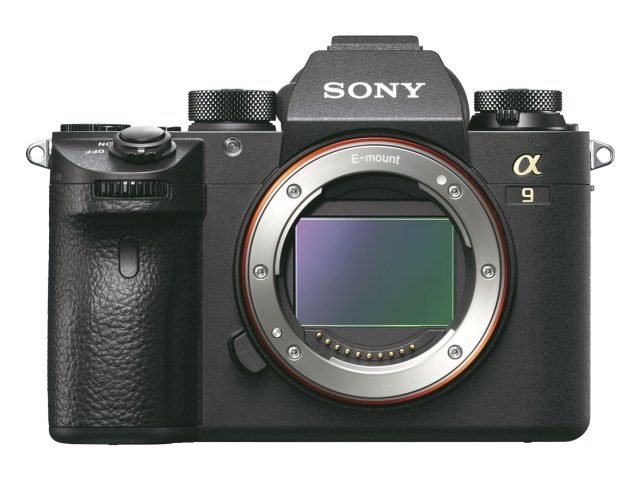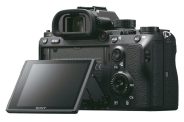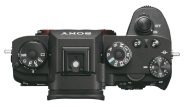Announced
Production status
System
Sony a9
35mm AF digital mirrorless camera
Specification
| Format: | |
| 35mm full frame | |
Imaging sensor: | 35.6 × 23.8mm CMOS sensor |
Resolution: | 6000 × 4000 - 24 MP |
Sensor-shift image stabilization: | Yes |
| Sony E [18mm] | |
| Shutter: | |
Type: | Focal-plane |
Model: | Electronically controlled |
Speeds: | 30 - 1/32000 + B |
| Exposure: | |
Exposure metering: | Through-the-lens (TTL), open-aperture |
Exposure modes: | Programmed Auto |
| Aperture-priority Auto | |
| Shutter-priority Auto | |
| Manual | |
| Physical characteristics: | |
Weight: | 673g |
Dimensions: | 126.9x95.6x73.7mm |
Manufacturer description
NEW YORK, Apr. 19, 2017 – Sony Electronics, a worldwide leader in digital imaging and the world’s largest image sensor manufacturer, has today introduced their new revolutionary digital camera, the α9 (model ILCE-9).
The most technologically advanced, innovative digital camera that Sony has ever created, the new α9 offers a level of imaging performance that is simply unmatched by any camera ever created – mirrorless, SLR or otherwise.
The new camera offers many impressive capabilities that are simply not possible with a modern digital SLR camera including high-speed, blackout-free continuous shooting3 at up to 20fps4, 60 AF/AE tracking calculations per second 10, a maximum shutter speed of up to 1/32,000 second8 and much more. These are made possible thanks to its 35mm full-frame stacked Exmor RS™ CMOS sensor – the world’s first of its kind – which enables data speed processing at up to 20x faster than previous Sony full-frame mirrorless cameras11. This unique sensor is paired with a brand new, upgraded BIONZ X processing engine and front end LSI that maximizes overall performance.
This industry-leading speed and innovative silent shooting7 is combined with a focusing system that features an incredible 693 phase detection AF points. Covering approximately 93% of the frame, the focusing system ensures that even the fastest moving subjects are reliably captured and tracked across the frame.
The new α9 also features a vibration free, fully electronic, completely silent anti-distortion shutter7 with absolutely no mechanical mirror or shutter noise, making it an extremely powerful photographic tool for any shooting situation that demands quiet operation. To ensure maximum usability and reliability, the camera features a new Z battery with approximately 2.2x the capacity of W batteries, as well as dual SD media card slots, including one that supports UHS-II cards. An Ethernet port (wired LAN terminal) is available as well, and there is a wide variety of new settings, controls and customizability options that are essential for working pros.
“This camera breaks through all barriers and limitations of today’s professional digital cameras, with an overall feature set that simply cannot be matched considering the restrictions of mechanical SLR cameras” said Neal Manowitz, Vice President of Digital Imaging at Sony Electronics. “But what excites us most about the α9 – more than its extensive product specs – is that it allows professionals to see, follow and capture the action in ways that were never before possible, unlocking an endless amount of new creative potential.”
A New Standard of Speed and Focusing Accuracy
Critical to the record-breaking speed of the new α9 is the combination of the new stacked 24.2 MP2 Exmor RS image sensor, new BIONZ X processor and front end LSI.
The immense processing power from these new components allows for faster AF/AE calculation while also reducing EVF display latency. The processor and front end LSI are also responsible for the larger continuous shooting buffer, enabling photographers to shoot at a blazing 20 fps4 with continuous AF/AE tracking for up to 362 JPEG6 or 241 RAW5 images.
The camera’s innovative AF system tracks complex, erratic motion with higher accuracy than ever before, with the ability to calculate AF/AE at up to 60 times per second10, regardless of shutter release and frame capture. Further, when the shutter is released while shooting stills, the electronic viewfinder functions with absolutely no blackout, giving the user a seamless live view of their subject at all times 12. This feature truly combines all of the benefits of an electronic viewfinder with the immediacy and “in the moment” advantages that not even the finest optical viewfinders can match, and is available in all still image modes including high speed 20 fps4 continuous shooting.
With 693 focal plane phase detection AF points covering approximately 93% of the frame, the camera ensures improved precision and unfailing focus in scenes where focus might otherwise be difficult to achieve. The Fast Hybrid AF system – pairing the speed and excellent tracking performance of phase detection AF with the precision of contrast AF – achieves approximately 25% faster performance when compared with α7R II, ensuring all fast-moving subjects are captured.
Professional Capabilities in a Compact Body
Sony’s new full-frame camera is equipped with a variety of enhanced capabilities that give it a true professional operational style.
The α9 features an all-new, high-resolution, high-luminance Quad-VGA OLED Tru-Finder with approximately 3,686k dots for extremely accurate, true-to-life detail reproduction. The new Tru-Finder, which is the highest resolution viewfinder ever for a Sony α camera, incorporates an optical design that includes a double-sided aspherical element, helping it to achieve 0.78x magnification and a level of corner to corner sharpness that is simply outstanding. The EVF also utilizes a ZEISS® T* Coating to greatly reduce reflections, and has a fluorine coating on the outer lens that repels dirt.
This all adds up to a luminance that is 2x higher than the XGA OLED Tru-Finder from the α7R II, creating a viewfinder image with a brightness level that is nearly identical to the actual scene being framed, ensuring the most natural shooting experience. The frame rate of the Tru-Finder is even customizable, with options to set it for 60 fps or 120 fps13 to best match the action.
The α9 is equipped with an innovative 5-axis image stabilization system that provides a shutter speed advantage of 5.0 steps 9, ensuring the full resolving power of the new sensor can be realized, even in challenging lighting. Also, with a simple half press of the shutter button, the effect of the image stabilization can be monitored in the viewfinder or on the LCD screen, allowing framing and focus to be accurately checked and continually monitored.
The α9 also offers an Ethernet port (wired LAN terminal), allowing convenient transfer of still image files to a specified FTP server at high-speed, making it an ideal choice for studio photography, high-profile news and sporting events and more. There is a sync terminal as well, enabling external flash units and cables to be connected directly for convenient flash sync.
New Features for Fast Operation
Sony’s new α9 has several new and updated focus functions that support faster, easier focusing in a variety of situations. The camera features a multi-selector joystick on the back of the camera, allowing shooters to easily shift focus point within the frame by pressing the multi-selector in any direction up, down, left or right when shooting in Zone, Flexible Spot or Expanded Flexible Spot focus area modes. The new model also offers touch focusing on the rear LCD screen for easily selecting of and shifting focus towards a desired focus point or subject.
New for Sony E-mount cameras, the α9 includes the addition of separate drive mode and focus mode dials, plus a new “AF ON” button that can be pressed to activate autofocus directly when shooting still images or movies.
Additional new capabilities include the “AF Area Registration”, which allows frequently used focus area to be memorized and recalled via custom button assignments. There is also the ability to assign specific settings (exposure, shutter speed, drive mode, etc) to a custom button to be instantly recalled when needed. The camera can memorize and automatically recall the last focus point used in a vertical or horizontal orientation as well, instantly switching back to it when that specific orientation is used again.
For enhanced customization, a “My Menu” feature is available, allowing up to 30 menu items to be registered in a custom menu for instant recall when needed.
Double Battery Life, Double Memory
The innovative α9 camera features an all-new Sony battery (model NP-FZ100) with 2.2x the capacity of previous Sony full-frame models, allowing for much longer shooting performance.
Also, based on extensive customer feedback, the new camera offers two separate media card slots, including one for UHS-II media. The same data can simultaneously be recorded to both cards, or the user can choose to separate RAW / JPEG or still images / movies. Movies can also simultaneously be recorded to two cards for backup and more efficient data management.
High Sensitivity and Wide Dynamic Range
The unique design of the α9 image sensor represents the pinnacle of Sony device technology. The 24.2 MP 2 full-frame stacked CMOS sensor is back-illuminated, allowing to capture maximum light and produce outstanding, true-to-life image quality. The sensor also enables the diverse ISO range of 100 – 51200, expandable to 50 – 20480014, ensuring optimum image quality with minimum noise at all settings.
The enhanced BIONZ X processor plays a large part in image quality as well, as it helps to minimize noise in the higher sensitivity range while also reducing the need to limit ISO sensitivity in situations where the highest quality image is required.
The new α9 also supports uncompressed 14-bit RAW, ensuring users can get the most out of the wide dynamic range of the sensor.
4K Video Capture
The new α9 is very capable as a video camera as well, as it offers 4K (3840x2160p) video recording across the full width of the full-frame image sensor15, 16. When shooting in this format, the camera uses full pixel readout without pixel binning to collect 6K of information, oversampling it to produce high quality 4K footage with exceptional detail and depth. Recording is also available in the popular Super 35mm size.
Additionally, the camera can record Full HD at 120 fps at up to 100 Mbps, which allows footage to be reviewed and eventually edited into 4x or 5x slow motion video files in Full HD resolution with AF tracking17.



